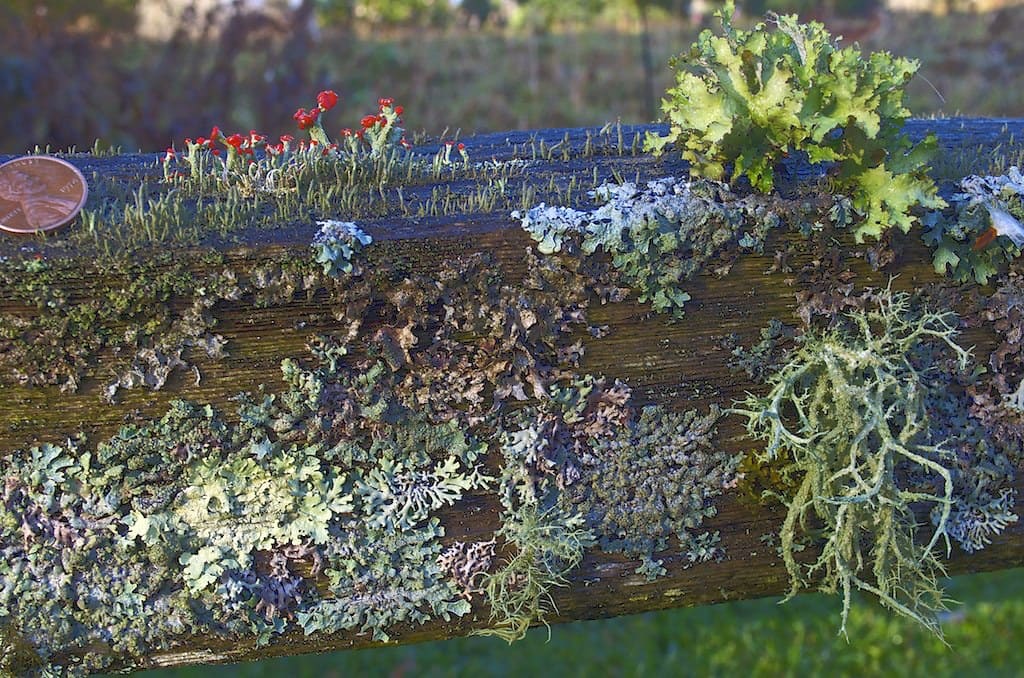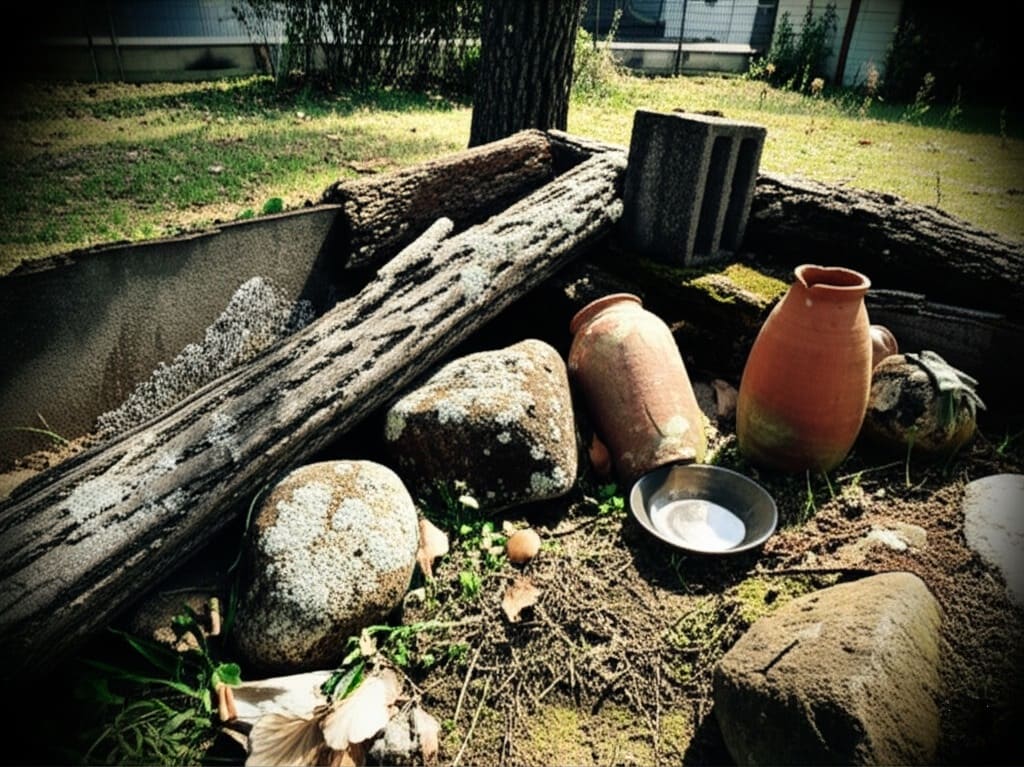A few winters ago, while pruning my old apple tree, I noticed what looked like tiny gray-green lettuce leaves growing on the bark. My first instinct was panic—was my beloved tree diseased?
After some research and a conversation with a local botanist, I discovered these weren’t signs of sickness but rather badges of honor, indicating that my garden’s air was clean enough to support these remarkable organisms called lichens.
What Exactly Are Lichens? Understanding Nature’s Ultimate Partnership
Lichens represent one of nature’s most fascinating success stories—a perfect example of symbiosis that has thrived for over 400 million years. Unlike the plants surrounding them, lichens aren’t a single organism but rather a composite being formed by the intimate partnership of multiple life forms working in perfect harmony.
The Core Partnership:
- Fungi (the mycobiont) provide the structural framework, protection, and water retention
- Algae or cyanobacteria (the photobiont) perform photosynthesis, creating food for all partners
The Recently Discovered Additional Partners: Modern research has revolutionized our understanding of lichen complexity.
In 2016, scientists discovered that many lichens also host yeast and other microorganisms, and recent metagenomic studies have identified over 150 different genomes within single lichen specimens, including multiple fungal classes and 14 bacterial phyla. This makes lichens some of the most complex symbiotic organisms on Earth.
This multi-partner alliance is so successful that lichens can survive in some of Earth’s harshest environments, from Arctic tundra to desert rocks, and there are approximately 3,600 known species in North America alone, making them among the most resilient and diverse life forms on our planet.
Read about Dead Man’s Fingers Fungi: A Spooky Discovery in Your Garden
The Three Main Types of Garden Lichens: Your Field Guide
Understanding lichen morphology helps you appreciate the diversity literally growing on your garden surfaces. Each growth form reflects different survival strategies and habitat preferences.
Foliose Lichens: The “Leafy” Type
- Appearance: Flat, leaf-like lobes that attach loosely to surfaces, resembling tiny lettuce leaves
- Texture: Slightly raised from the substrate with defined, often wavy edges
- Growth Pattern: Spreads horizontally across surfaces, can overlap to form large patches
Common Garden Examples:
- Xanthoria parietina (Common Orange Lichen): Vibrant yellow-orange patches that become especially noticeable in winter months
- Peltigera species (Dog Lichens): Large brown or gray lobes with visible root-like structures (rhizines) underneath
- Punctelia species: Gray-green with pale undersides, often found on tree bark
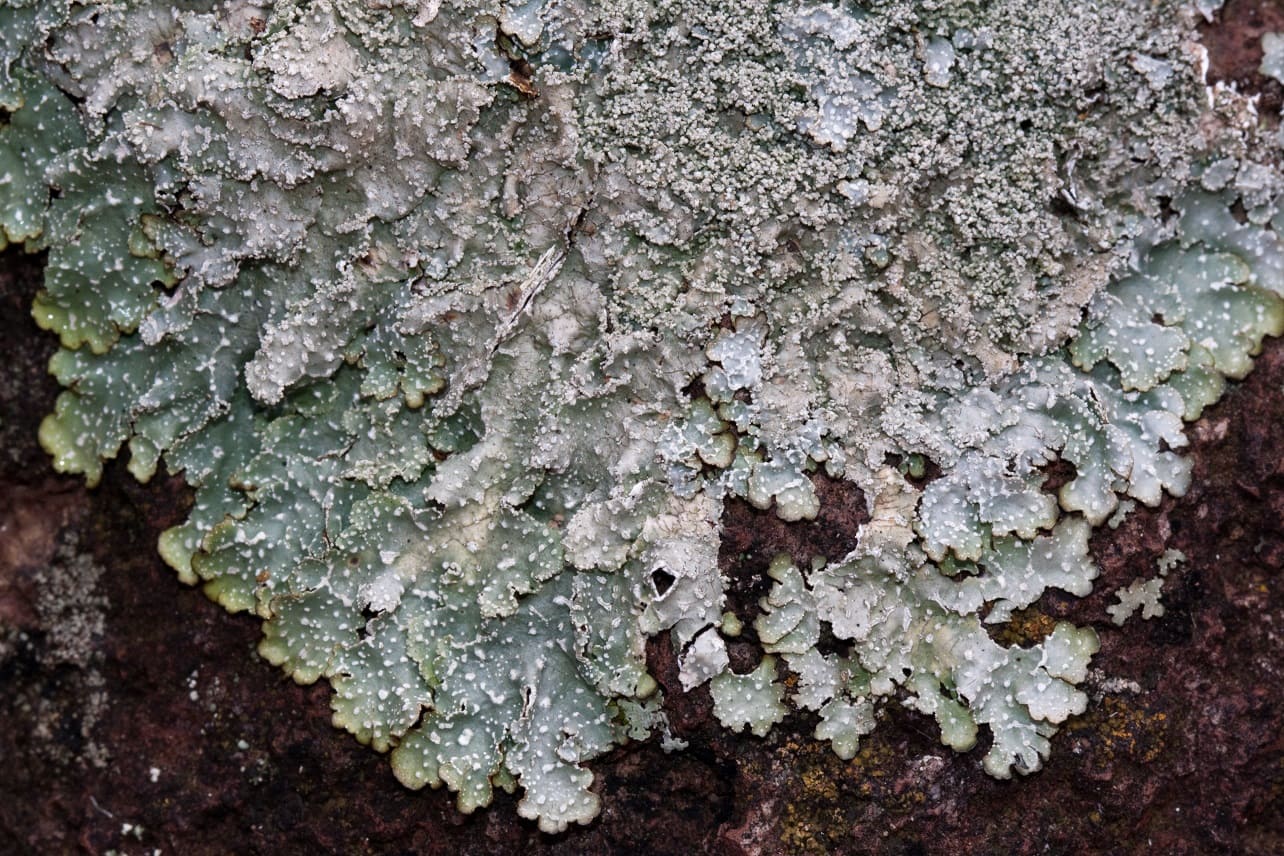
Garden Locations: Tree trunks, wooden fence posts, garden benches, rock walls
Identification Tip: If you can gently lift the edges with your fingernail without damaging the surface underneath, you’re likely looking at a foliose lichen.
Fruticose Lichens: The “Shrubby” Type
- Appearance: Three-dimensional growth that stands upright or hangs down from surfaces
- Texture: Branched, tufted, or hair-like structures with cylindrical branches
- Growth Pattern: Grows vertically or pendulously, attached by a single point
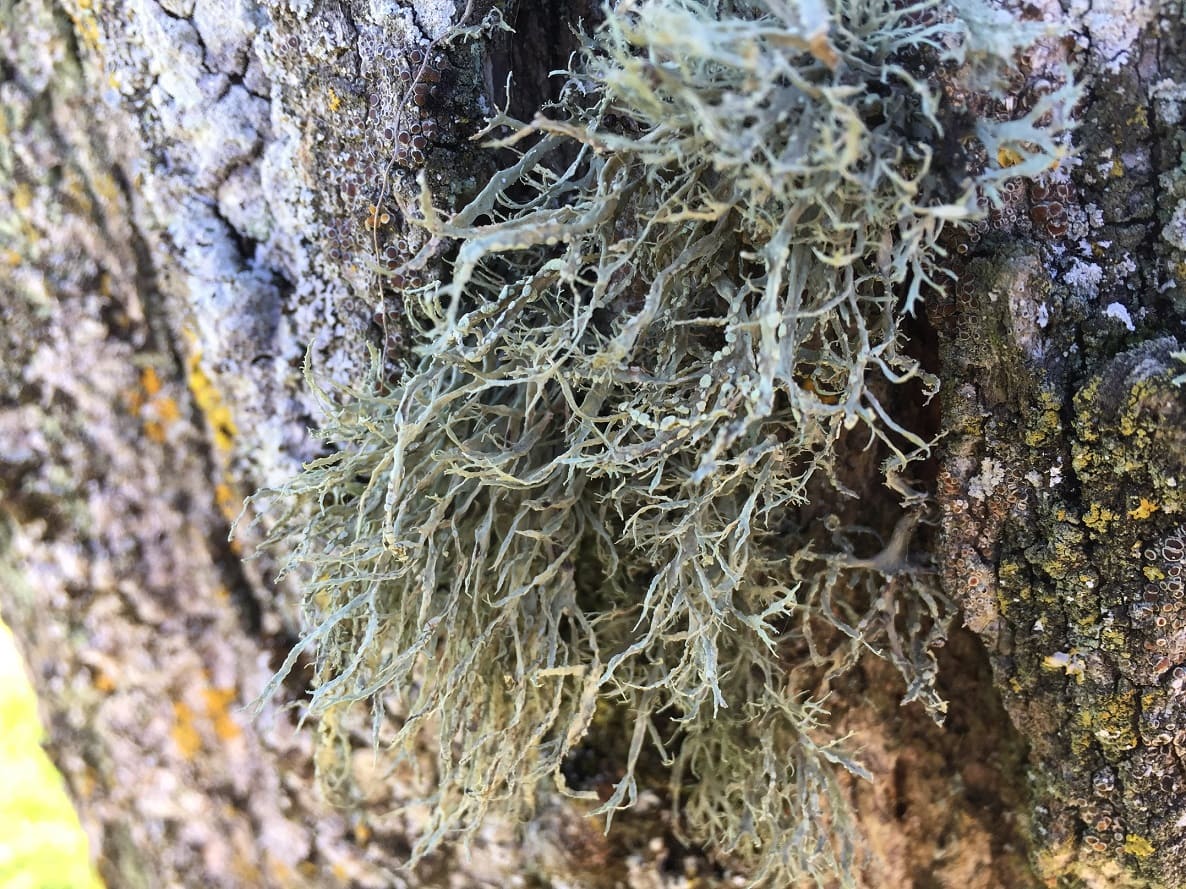
Common Garden Examples:
- Ramalina farinacea (Shaggy Strap Lichen): Pale gray-green tufts commonly found on tree branches
- Usnea species (Old Man’s Beard): Long, hanging, beard-like growths
- Cladonia species (Cup Lichens): Small, cup-shaped structures on soil or rotting wood
Garden Locations: Tree branches, wooden structures, occasionally on soil in undisturbed areas
Identification Tip: These lichens have obvious height and dimension—they create miniature forests on their substrates.
Crustose Lichens: The “Crusty” Type
- Appearance: Thin, flat crusts that appear painted directly onto surfaces
- Texture: Tightly adherent with well-defined margins, often forming geometric patterns
- Growth Pattern: Spreads horizontally in patches, impossible to remove without damaging the substrate
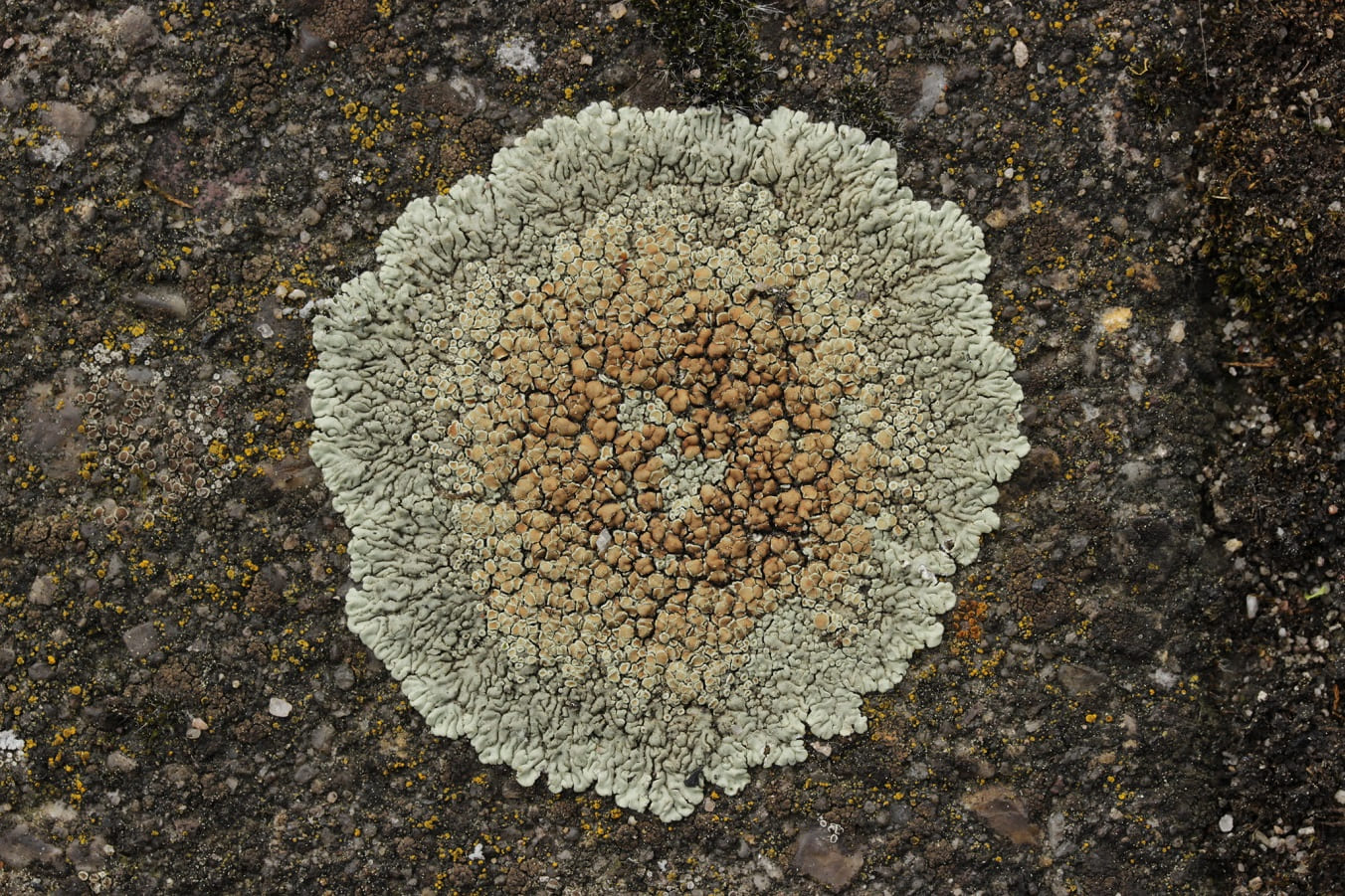
Common Garden Examples:
- Protoparmeliopsis muralis (Stonewall Rim Lichen): Greenish-gray patches on walls and timber
- Caloplaca species: Bright orange or yellow crusts on concrete and stone
- Graphis species: Forms script-like patterns on smooth bark
Garden Locations: Stone walls, concrete surfaces, wooden structures, smooth-barked trees
Identification Tip: These appear almost painted on and cannot be peeled off—they’re permanently bonded to their surface.
Where Lichens Grow and What It Tells You About Your Garden
Lichens serve as living environmental sensors, providing real-time information about your garden’s ecological health. Their presence and diversity patterns reveal hidden stories about air quality, microclimate, and ecosystem stability.
Preferred Growing Conditions
- Clean Air Requirements: Lichens are extremely sensitive to air pollution and are considered indicators of good air quality—their presence means your environment is clean enough to support them. Different species have varying pollution tolerances, creating a natural gradient of environmental sensitivity.
- Surface Stability: Lichens require undisturbed surfaces for establishment. They thrive on substrates that won’t be frequently cleaned, moved, or rapidly shed.
- Moisture Balance: While remarkably drought-tolerant, lichens need periodic moisture to remain metabolically active. They can survive complete desiccation and reactivate when water becomes available.
- Substrate Specificity: Each species has distinct surface preferences. Bark-specialists rarely colonize stone, while rock-loving species seldom establish on wood. This specificity creates predictable distribution patterns throughout your garden.
Reading Your Garden’s Lichen Map
The distribution and abundance of lichens create a living environmental map:
- Directional Patterns: Northern sides of trees often host more moisture-loving species due to reduced sun exposure and consistent humidity.
- Age Indicators: Older, slower-growing trees provide more stable surfaces ideal for lichen establishment, while fast-growing trees constantly shed bark, making colonization difficult.
- Health Signals: Sudden lichen prominence on previously lichen-free trees may indicate reduced plant vigor, as sparse canopies allow more light penetration.
Last spring, I noticed my grandmother’s old lilac bush, which had been struggling for years, was suddenly adorned with beautiful orange and gray lichens.
Rather than causing the bush’s decline, these lichens were simply taking advantage of the increased light filtering through the increasingly sparse canopy—nature’s way of making use of every available ecological niche.
Here’s How to Grow and Care for Lilacs: The Ultimate Guide For Beginners
Lichens as Your Garden’s Environmental Report Card
Understanding lichen communities transforms your garden observation skills, turning casual notice into informed environmental assessment.
Air Quality Biomonitoring
Species Diversity = Air Quality: Gardens supporting numerous lichen species indicate excellent air quality. Industrial pollutants, particularly sulfur dioxide from coal burning, quickly eliminate sensitive species, while lichens can tolerate minimal nitrogen dioxide from traffic.
Explore the Best Air-Purifying Indoor Plants That Thrive Without Direct Sunlight
Pollution-Specific Indicators:
- Crustose lichens dominating: May indicate elevated nitrogen levels from vehicle exhaust or agricultural sources
- Diverse foliose and fruticose species: Suggests minimal sulfur dioxide and good overall air quality
- Complete absence: Could signal significant air quality issues requiring investigation
Microclimate Revelations
Lichen distribution patterns reveal your garden’s hidden microclimates:
- Concentrated growth areas: Indicate stable, protected microzones with consistent moisture
- Species transitions: Mark boundaries between different environmental conditions
- Seasonal visibility changes: Reflect humidity and temperature fluctuation patterns
The Hidden Ecosystem Services of Garden Lichens
Beyond their environmental indicator role, lichens provide numerous ecosystem services that actively enhance your garden’s health and biodiversity.
Nitrogen Fixation and Natural Fertilization
Many lichen species, particularly those containing cyanobacteria, actively fix atmospheric nitrogen. This process converts inert atmospheric nitrogen gas into biologically available nitrates and nitrites.
When rain washes over lichen-covered surfaces, it carries these nitrogen compounds to surrounding soil, providing slow-release, natural fertilization for nearby plants.
The Nitrogen Cycle Connection:
- Lichens capture atmospheric nitrogen
- Specialized bacteria within the lichen convert it to usable forms
- Rain and dew leach these compounds from living and dead lichens
- Surrounding plants receive steady nitrogen supplementation
- Garden soil fertility gradually improves in lichen-rich areas
This natural fertilization system operates continuously, providing plants with nutrients exactly when moisture is available for uptake.
Pioneer Species and Soil Development
Lichens excel as ecological pioneers, often being the first organisms to colonize bare rock or severely disturbed areas. Their colonization process creates the foundation for ecological succession:
The Succession Process:
- Lichen spores establish on bare surfaces
- Slow growth creates organic matter accumulation
- Chemical weathering of rock substrates begins
- Dust and debris become trapped in lichen structures
- Micro-soil pockets develop
- Mosses and small plants can establish
- Larger plant communities gradually develop
This process, though slow, transforms unsuitable habitats into thriving ecosystems over decades or centuries.
Here’s How to Turn Fall Leaves into Soil Enriching Mulch For a Nutrient-Rich Garden
Wildlife Support Networks
Nesting Material Sources: Over 50 bird species regularly use fruticose lichens as preferred nesting material, with ruby-throated hummingbirds particularly favoring lichen strips for lining their tiny nests.
Food Web Integration: While not highly nutritious, lichens support various wildlife:
- Large herbivores: Caribou and reindeer depend heavily on lichen during winter months
- Small mammals: Squirrels occasionally browse lichens
- Invertebrates: Slugs, snails, and various insects graze on lichen surfaces
- Microscopic life: Lichen structures house countless tiny organisms from springtails to tardigrades
Shelter Provision: The complex three-dimensional structure of lichen communities creates microhabitats for numerous small creatures, contributing significantly to garden biodiversity.
Read The Complete Guide to Hedgerows: Wildlife Havens for Your Property
Traditional and Modern Applications
Lichens have served human needs throughout history and continue to offer potential benefits:
Historical Uses:
- Natural Dyes: Traditional textiles worldwide rely on lichen-based colors, including the famous Harris tweed
- Medicine: Various cultures used lichens for treating respiratory ailments and wounds
- Food: Though mostly unpalatable, species like Iceland moss provided emergency sustenance
- pH Testing: Litmus paper derives from lichen compounds

Modern Applications:
- Environmental monitoring: Scientists use lichen communities to assess ecosystem health
- Pharmaceutical research: Investigation of lichen compounds for antibiotic and anti-cancer properties
- Climate research: Long-lived lichens provide data about historical environmental conditions
Debunking Common Lichen Myths
Despite their benefits, lichens often face misconceptions that lead to unnecessary removal efforts and missed appreciation opportunities.
Myth #1: “Lichens Are Killing My Tree”
Reality: Lichens are completely harmless epiphytes that use trees only for physical support while obtaining all nutrients from air and rainfall. Research consistently shows no association between lichen presence and plant pathogens.
The Visibility Paradox: Lichens become more noticeable on struggling trees because sparse canopies allow more light to reach bark surfaces, making existing lichens more visible and encouraging new growth. The lichen isn’t causing the problem—it’s just becoming easier to see.
Myth #2: “Lichens Spread Plant Disease”
Reality: Extensive research has found no evidence that lichens harbor or transmit plant diseases. They maintain complete nutritional independence from their host surfaces.
Myth #3: “I Must Remove Lichens to Save My Plants”
Reality: Attempting to physically remove lichens from living plants often causes more damage than leaving them alone, as scraping can wound bark and create entry points for actual pathogens.
A neighbor once spent an entire weekend scraping lichens off their oak tree with a wire brush, convinced they were saving it. The tree subsequently developed several infections where the bark was damaged, while my similar oak, with its lichens intact, remained perfectly healthy.
The lesson was clear: sometimes the cure causes more harm than the supposed problem.
When to Remove Lichens (And When to Leave Them Alone)
Making informed decisions about lichen management requires understanding when their presence might genuinely conflict with your garden goals.
Always Leave Lichens Alone On:
- Living trees and shrubs: Removal risks bark damage without providing any benefit
- Wooden fences and structures: Unless aesthetics are a primary concern
- Rock gardens and natural stone features: Lichens add character and indicate environmental health
- Areas where you want to encourage biodiversity
Consider Careful Removal From:
- Stone Sculptures and Decorative Statuary: Over time, certain lichens can gradually penetrate and deteriorate stone surfaces through slow chemical weathering processes.
- Safety-Critical Surfaces: Algae and some lichens can make walkways, steps, and wooden decking dangerously slippery when wet.
- Prized Ornamental Bark: If you’re growing trees specifically for their decorative bark patterns (like paper birch or cherry), you might choose to gently discourage lichen establishment.
Safe and Effective Removal Methods
When removal becomes necessary, choose methods that minimize environmental impact:
For Hard Surfaces:
- Soft brushing: Use natural bristle brushes for delicate stone surfaces
- Pressure washing: Effective but may spread spores to new locations
- Copper-based treatments: For persistent problems on non-living surfaces only
- Commercial stone cleaners: Follow manufacturer instructions carefully

For Plant Management: Rather than direct removal, improve growing conditions:
- Enhance air circulation through selective pruning
- Improve soil drainage and fertility
- Provide appropriate watering during stress periods
- Apply organic mulch to support root health
How to Create a Lichen Garden: Welcoming These Beneficial Organisms
Rather than fighting lichens, why not intentionally create spaces that encourage their establishment? A lichen garden becomes a living laboratory for observing these remarkable organisms.
Step-by-Step Lichen Garden Creation
Step 1: Choose the Right Location
- Select a partially shaded area that receives morning sun but afternoon protection
- Ensure good air circulation without excessive wind exposure
- Avoid areas subject to foot traffic or frequent disturbance
- Consider proximity to existing lichen populations for natural colonization
Step 2: Prepare Suitable Substrates
- Collect weathered wood pieces with existing lichen growth (with permission)
- Gather various stone types: sandstone, limestone, and granite offer different surfaces
- Include some concrete blocks or terra cotta for diverse colonization opportunities
- Arrange materials at different heights and orientations
Step 3: Create Optimal Conditions
- Establish consistent but not excessive moisture through strategic placement
- Position containers nearby to create beneficial microclimates
- Avoid using any fungicides or chemical treatments in the area
- Allow natural debris accumulation to create organic matter
Step 4: Encourage Natural Colonization
- The Yogurt Method: Paint diluted plain yogurt onto stone surfaces to encourage establishment
- Patience Protocol: Allow 2-3 years for initial colonization—lichen establishment is naturally slow
- Observation Schedule: Check monthly for new growth, photographing changes over time
Step 5: Monitor and Document
- Record seasonal changes in color and growth patterns
- Note which surfaces attract different lichen types
- Track environmental conditions that promote or inhibit growth
- Create a photographic record of your lichen garden’s development
Maintenance and Care Guidelines
- Water Management: Provide light misting during extended dry periods, but avoid overwatering which can encourage moss competition.
- Substrate Stability: Resist the urge to move or rearrange materials once lichens begin establishing.
- Chemical-Free Zone: Maintain the area without pesticides, herbicides, or fungicides that could harm sensitive lichen communities.
Three years ago, I established a small lichen garden in a forgotten corner behind my shed, using old bricks and fallen branches. Last month, I discovered my first tiny patches of bright orange crustose lichens beginning to colonize the rough brick surfaces—a thrilling sign that my garden’s ecosystem is maturing and developing its own natural character.
Seasonal Lichen Watching: A Year-Round Garden Feature
Lichens provide dynamic seasonal interest that changes dramatically throughout the year, offering observational opportunities that many gardeners overlook.
Winter: Peak Visibility Season (December-February)
Winter offers optimal lichen viewing conditions:
- Enhanced contrast: Lichens stand out dramatically against bare branches and gray bark
- Maximum light penetration: Deciduous canopies allow full illumination of trunk and branch lichens
- Vibrant coloration: Cold, moist conditions bring out the most intense lichen colors
- Species differentiation: Different growth forms become easily distinguishable
- Photography opportunities: Snow provides excellent background contrast for documentation

Spring: Active Growth Period (March-May)
As temperatures moderate and moisture increases:
- Fresh growth: New lichen tissue appears bright and vibrant
- Reproductive structures: Some species develop visible fruiting bodies
- Color intensity: Increased photosynthetic activity enhances pigmentation
- Rehydration response: Previously dormant lichens rapidly reactivate
- Colonization events: Optimal conditions for spore establishment on new surfaces
Summer: Protective Dormancy (June-August)
During hot, dry summer months:
- Color fading: Many lichens appear dusty or bleached as they enter dormancy
- Growth cessation: Metabolic activity slows or stops entirely during drought
- Protective mode: Some species may appear to shrink or curl for moisture conservation
- Substrate visibility: Dormant lichens reveal the textures and patterns of their host surfaces
Fall: Reactivation Period (September-November)
Returning autumn moisture brings:
- Color restoration: Lichens rapidly rehydrate and resume photosynthesis
- Renewed growth: Fresh tissue development prepares for winter activity
- Spore release: Many species reproduce during favorable autumn conditions
- Preparation phase: Lichens build reserves for winter’s active growing season
Find out Why You Should Leave Fall Leaves on Your Lawn and Garden
Geographic and Climate Considerations
Understanding how climate affects lichen communities helps set realistic expectations for your specific location and creates better management strategies.
Regional Lichen Patterns
- Temperate Maritime Climates: Areas with consistent moisture and moderate temperatures support the highest lichen diversity, with the UK hosting over 2,000 lichen species despite its small size.
- Continental Climates: Seasonal extremes favor hardy species adapted to temperature fluctuations and periodic drought.
- Arid Regions: Desert lichens display remarkable drought tolerance but may require years between active growth periods.
- Urban vs. Rural Environments: City gardens typically host fewer lichen species due to air pollution, making their presence an even stronger indicator of good local air quality.
Climate Change Adaptations
Recent research reveals that lichens demonstrate remarkable adaptability to changing conditions through partner switching—the ability of fungal partners to associate with different algal species as environmental conditions change, providing resilience against climate variability.
Frequently Asked Questions About Garden Lichens
- Q: Will lichens harm my fruit trees or affect fruit quality?
A: Absolutely not. Lichens are completely harmless to trees and don’t affect fruit production or quality. In fact, their presence on fruit trees indicates the clean air that’s beneficial for both the lichens and optimal fruit development. Many organic orchards specifically welcome lichens as signs of pesticide-free environments.
- Q: Can I transplant lichens from one location to another in my garden?
A: Unlike plants, lichens are extremely difficult to transplant successfully. Their complex symbiotic relationships and substrate dependencies make relocation nearly impossible. Instead, create suitable conditions and allow natural colonization, which typically takes 2-5 years for visible establishment.
- Q: Why do some of my trees have abundant lichens while others have none?
A: Several factors influence lichen colonization patterns: Tree age (older trees provide more stable surfaces), bark texture (rough bark offers better attachment sites), growth rate (fast-growing trees constantly shed bark), light exposure (adequate light supports photosynthesis), and local microclimate (moisture and air circulation patterns). Each tree creates unique conditions that may or may not suit lichen establishment.
- Q: Are lichens a sign that my tree is dying?
A: Not necessarily. While lichens may become more noticeable on stressed trees due to thinner canopies allowing increased light penetration, they don’t cause decline.
If your tree shows other symptoms like extensive dead branches, yellowing leaves, or poor annual growth, investigate other potential causes such as root problems, diseases, or environmental stresses.
- Q: How can I tell the difference between lichens, moss, and algae in my garden?
A: Moss grows in soft, cushiony mats with tiny leaf-like structures, stays bright green when moist, and requires consistently damp conditions. Algae appears as thin, often slimy films on wet surfaces, usually bright green or sometimes orange-red. Lichens have more varied forms (crusty, leafy, or branching), come in diverse colors including gray, orange, and yellow, and can tolerate much drier conditions. Lichens also feel more substantial and structured compared to moss or algae.
Advanced Lichen Observation Techniques
For gardeners who want to deepen their lichen appreciation, developing systematic observation skills transforms casual interest into meaningful understanding.
Documentation Methods
- Photography Protocol: Take photos of the same lichen colonies monthly, noting seasonal changes in color, size, and reproductive structures. Use a ruler or coin for scale reference.
- Growth Monitoring: Mark lichen edges with non-toxic markers to track expansion rates, which typically measure millimeters per year.
- Weather Correlation: Note how lichens respond to rainfall, humidity changes, and temperature fluctuations in your specific microclimate.
Identification Resources
- Field Guides: Invest in regional lichen identification guides that include your geographic area’s common species.
- Online Communities: Join local naturalist groups or online forums where experienced lichenologists share identification tips and regional expertise.
- Magnification Tools: A simple 10x hand lens reveals intricate lichen structures invisible to the naked eye, dramatically enhancing identification accuracy.
Conclusion: Embracing Your Garden’s Lichen Legacy
Discovering and welcoming lichens in your garden represents a significant milestone in environmental stewardship. These remarkable organisms serve as living certificates of your garden’s ecological health, proving that your outdoor space supports complex, beneficial ecosystems that have been perfecting their partnerships for hundreds of millions of years.
Rather than viewing lichens as problems requiring solutions, consider them as garden allies worthy of protection and celebration. They work continuously to improve soil fertility, support wildlife populations, and create subtle beauty that changes with every season.
Each lichen colony represents years or decades of patient growth—a testament to your garden’s environmental stability and your success in creating healthy growing conditions.
The next time you notice gray-green patches on your trees, colorful crusts on your garden walls, or delicate tufts hanging from branches, pause to appreciate these small marvels.
You’re witnessing some of nature’s most successful collaborations, thriving in your own backyard—partnerships so effective they’ve survived multiple mass extinctions and continue to colonize new environments worldwide.
As I conclude this guide, sitting in my garden on a misty morning, I count at least eight different lichen species visible from my chair. The old apple tree that first introduced me to these fascinating organisms now hosts a dozen species creating a living tapestry that transforms with each season.
My garden feels richer and more complete knowing it supports these ancient alliances—a reminder that the most remarkable gardens are those that welcome and celebrate all forms of life, no matter how small or seemingly insignificant.
Understanding and appreciating lichens connects you to a larger story of cooperation, resilience, and ecological interconnectedness that spans geological time. By learning to read the lichen language in your garden, you become not just a better gardener, but a more informed participant in the remarkable web of life that surrounds us all.
Remember: Every lichen colony in your garden represents multiple successful partnerships working in harmony—fungi, algae, bacteria, and countless microorganisms collaborating to create something beautiful and beneficial.
In our increasingly fragmented world, lichens remind us that cooperation, patience, and mutual support remain the most powerful forces for creating sustainable, thriving communities.
